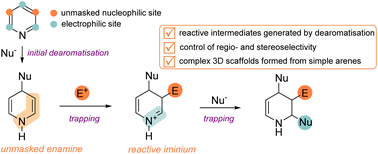Recent advances in the dearomative functionalisation of heteroarenes
Abstract
Dearomatisation reactions of (hetero)arenes have been widely employed as efficient methods to obtain highly substituted saturated cyclic compounds for over a century. In recent years, research in this area has shifted towards effecting additional C–C bond formation during the overall dearomative process. Moving away from classical hydrogenation-based strategies a wide range of reagents were found to be capable of initiating dearomatisation through nucleophilic addition (typically a reduction) or photochemically induced radical addition. The dearomatisation process gives rise to reactive intermediates which can be intercepted in an intra- or intermolecular fashion to deliver products with significantly increased molecular complexity when compared to simple dearomatisation. In this Perspective recent examples and strategies for the dearomative functionalisation of heteroaromatic systems will be discussed.

- This article is part of the themed collection: 2022 Chemical Science Perspective & Review Collection


 Please wait while we load your content...
Please wait while we load your content...